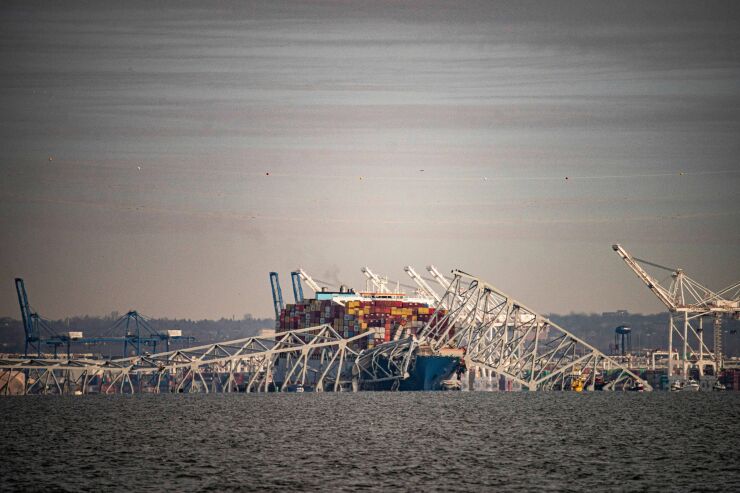Key Bridge in Baltimore collapses after catastrophic ship collision
3 min read

Tragedy struck a main span of the Key Bridge in the Baltimore Inner Harbor at 1:30 am Tuesday when the Singapore-flagged container vessel Dali crashed into a bridge support, toppling the bond-financed toll bridge.
As of this morning, six people are missing in the catastrophe that is currently being attributed to the freighter losing power while leaving the harbor at a speed of eight knots. Baltimore Fire Chief James Wallace was quoted on CNN saying that sonar has revealed five vehicles on the bed of the Patapsco River at a depth of 50 feet. At the time of the crash, eight workers were on the bridge fixing potholes, two were rescued, six remain missing.
Bloomberg
“The crew that was out there working was basically repairing potholes, just so you understand that it had nothing to do with a structural issue at all at the facility,” said Paul J. Wiedefeld, secretary, Maryland Department of Transportation. “Engineers are on site right now, but we’ll work hand in hand with the National Transportation Safety Board before we take any further action.”
The 1.6-mile-long Francis Scott Key Bridge spans the Patapsco River just south of Baltimore’s Inner Harbor and carries over 31,000 cars a day via four lanes of traffic traveling along I-695, a bypass around downtown Baltimore.
The bridge is a key contributor to the Maryland Transportation Authority’s (MDTA) revenue stream as questions about insurance are being raised. According to the MDTA it “maintains a comprehensive program of insurance covering loss of revenues, general liability, and damage to bridges, tunnels, elevated roadways, approaches, and other property.”
The bridge was financed by a $220 million revenue bond issuance in 1968 and its tolls which generated over $56 million in 2023.
Eric Kazatsky, Bloomberg intelligence strategist, notes that there are “about $2.6 billion of outstanding bonds secured by revenue derived from the ownership and operation of the Transportation Facilities Projects.”
He also points to a rate covenant that obligates the MDTA to “fix, revise, charge and collect rentals, rates, fees, tolls and other charges/revenues for the use or services of the Transportation Facilities Projects in order to produce net revenues in each bond year in an amount not less than the sum of (120%) of the amount of the debt service requirement for such bond year on account of all bonds and any parity indebtedness then outstanding.”
The MDTA has a strong debt service coverage ratio that has been measured at 3.1x to 4x. “Growing projected debt service will push that coverage level slightly below 1.9x in 2029, absent the latest disaster,” said Kazatsky,
Construction on the bridge began in 1972 and it opened in 1977. It’s been hailed as “a significant engineering accomplishment,” and is one of the longest continuous-truss bridges in the United States, according to the American Society of Civil Engineers.
According to reports during its construction, a section of the water crossing was originally conceived as a two-lane tunnel which would have added $15 million to the cost.
While the second bridge span was being built, bids for laying the tunnel came in $18 million over budget forcing the State Roads Commission to opt for a bridge all the way across.
The move was opposed by the maritime industry citing navigation hazards. Engineers are pointing to the massive size of today’s freighters as being no match for a 1970’s-era bridges.







